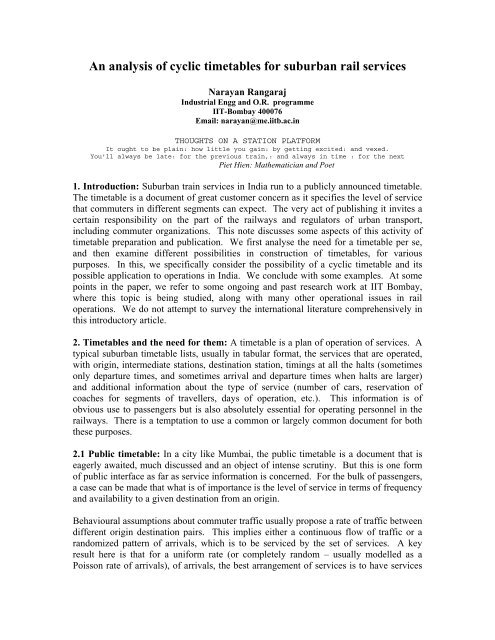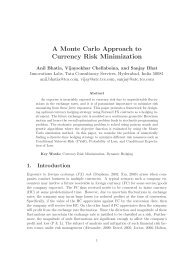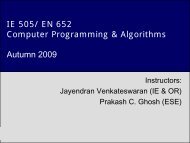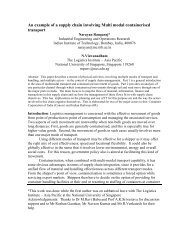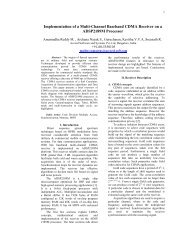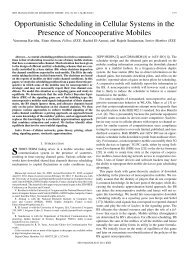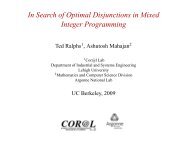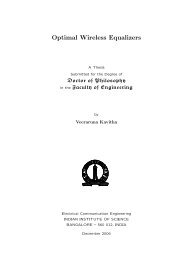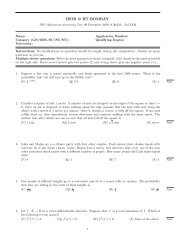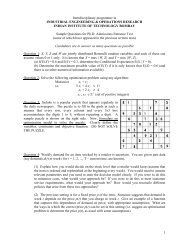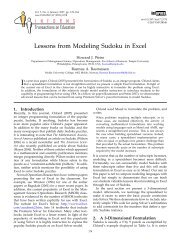cyclic timetables - Industrial Engineering and Operations Research ...
cyclic timetables - Industrial Engineering and Operations Research ...
cyclic timetables - Industrial Engineering and Operations Research ...
Create successful ePaper yourself
Turn your PDF publications into a flip-book with our unique Google optimized e-Paper software.
An analysis of <strong>cyclic</strong> <strong>timetables</strong> for suburban rail servicesNarayan Rangaraj<strong>Industrial</strong> Engg <strong>and</strong> O.R. programmeIIT-Bombay 400076Email: narayan@me.iitb.ac.inTHOUGHTS ON A STATION PLATFORMIt ought to be plain: how little you gain: by getting excited: <strong>and</strong> vexed.You'll always be late: for the previous train,: <strong>and</strong> always in time : for the nextPiet Hien: Mathematician <strong>and</strong> Poet1. Introduction: Suburban train services in India run to a publicly announced timetable.The timetable is a document of great customer concern as it specifies the level of servicethat commuters in different segments can expect. The very act of publishing it invites acertain responsibility on the part of the railways <strong>and</strong> regulators of urban transport,including commuter organizations. This note discusses some aspects of this activity oftimetable preparation <strong>and</strong> publication. We first analyse the need for a timetable per se,<strong>and</strong> then examine different possibilities in construction of <strong>timetables</strong>, for variouspurposes. In this, we specifically consider the possibility of a <strong>cyclic</strong> timetable <strong>and</strong> itspossible application to operations in India. We conclude with some examples. At somepoints in the paper, we refer to some ongoing <strong>and</strong> past research work at IIT Bombay,where this topic is being studied, along with many other operational issues in railoperations. We do not attempt to survey the international literature comprehensively inthis introductory article.2. Timetables <strong>and</strong> the need for them: A timetable is a plan of operation of services. Atypical suburban timetable lists, usually in tabular format, the services that are operated,with origin, intermediate stations, destination station, timings at all the halts (sometimesonly departure times, <strong>and</strong> sometimes arrival <strong>and</strong> departure times when halts are larger)<strong>and</strong> additional information about the type of service (number of cars, reservation ofcoaches for segments of travellers, days of operation, etc.). This information is ofobvious use to passengers but is also absolutely essential for operating personnel in therailways. There is a temptation to use a common or largely common document for boththese purposes.2.1 Public timetable: In a city like Mumbai, the public timetable is a document that iseagerly awaited, much discussed <strong>and</strong> an object of intense scrutiny. But this is one formof public interface as far as service information is concerned. For the bulk of passengers,a case can be made that what is of importance is the level of service in terms of frequency<strong>and</strong> availability to a given destination from an origin.Behavioural assumptions about commuter traffic usually propose a rate of traffic betweendifferent origin destination pairs. This implies either a continuous flow of traffic or ar<strong>and</strong>omized pattern of arrivals, which is to be serviced by the set of services. A keyresult here is that for a uniform rate (or completely r<strong>and</strong>om – usually modelled as aPoisson rate of arrivals), of arrivals, the best arrangement of services is to have services
<strong>timetables</strong> which require specific timings of all services, both the optimizationcriteria <strong>and</strong> the methods for construction are cumbersome.• In actual operation, the timetable allows easy recovery from minor disruptions toservices.• The timetable allows customers to plan journeys more precisely, withoutnecessarily having access to a complicated timetable document. This leads tobetter spread of load on coaches <strong>and</strong> better utilisation of available rolling stock.Cyclic <strong>timetables</strong> have been dem<strong>and</strong>ed by large passenger associations (which representa large commuting group), because of the benefits stated above, although there willalways be specific dem<strong>and</strong>s of local groups for specific services.There are some practical difficulties in operating <strong>cyclic</strong> <strong>timetables</strong> in the Indianenvironment. Some of them are as below.• Terminal facilities do not exist at all stations where dem<strong>and</strong> exists for originatingservices.• Some locations are served by very occasional services where a frequency basedservice does not make sense to commuters. For such locations, timed services arepreferred by customers.• Suburban services are run on tracks which are also shared by long distanceservices which run at certain specified times, which may not be suitable for a<strong>cyclic</strong> timetable.• Customers are used to timings that are announced in advance, even though theyare not necessarily followed to the minute.It must be emphasised that the benefit of a <strong>cyclic</strong> timetable is more during peakcommuting times where the customer pattern is of the stated time. At other times, other<strong>timetables</strong> may be quite acceptable from the various points of view that have beendiscussed. So it is entirely feasible to have a combination of a <strong>cyclic</strong> timetable duringpeak hours <strong>and</strong> a non-<strong>cyclic</strong> timetable during other times. Announcing times in case of a<strong>cyclic</strong> timetable is an option: for a non <strong>cyclic</strong> timetable, announcing times is generallypracticed.4. Construction of <strong>timetables</strong>: A <strong>cyclic</strong> timetable can be specified concisely <strong>and</strong> can beabstracted using a limited number of patterns [5]. Once this is done, an optimizationprocedure is possible using this representation.On the other h<strong>and</strong>, a timetable, which requires specific times of all services, is difficult tooptimize <strong>and</strong> generally, more attention is paid to helping the timetabler to construct anoperationally feasible timetable. In fact, the factors that make it difficult to construct
<strong>cyclic</strong> <strong>timetables</strong> are; one-off services, non-regular requirements <strong>and</strong> a large number ofservice patterns. These factors make it necessary to allow the timetabler more control ofthe construction procedure <strong>and</strong> checking feasibility itself is a non-trivial task. Constraintbased techniques seem best suited for this purpose [5].Apart from railway constructed <strong>timetables</strong>, an example of a <strong>cyclic</strong> timetable proposed bypassenger groups is the one suggested by the Mumbai Suburban Railways PassengerAssociation [2].5. Examples: We now list several examples of <strong>cyclic</strong> <strong>and</strong> non-<strong>cyclic</strong> <strong>timetables</strong> in rail,bus <strong>and</strong> air operations in India. These examples are illustrative in nature <strong>and</strong> the specific<strong>timetables</strong> continue to evolve as the networks <strong>and</strong> the dem<strong>and</strong> for services continue tochange over time.• Harbour line operations on Central Railway in Mumbai:i. CST- Panvel: Cyclic. In a time cycle of one hour, the following pattern isobserved. Roughly four trains within one hour, two trains on CST-Panvel sectionfollowed by one train on CST-Andheri section with a time gap 5min-5min-10min-5min-5min-10min…ii. CST-Andheri: Partly <strong>cyclic</strong> with trains every 30 min. to Andheri, alternatetrains on CST-Andheri <strong>and</strong> CST-B<strong>and</strong>ra sections• Main line operations on Central Railway in Mumbai:i. Slow corridor: Cyclic at Kurla station with trains every 5 min.ii. Fast corridor: Not <strong>cyclic</strong>.• Western Railway operations in Mumbai are largely <strong>cyclic</strong> during the peak hours.• Suburban operations on the Arakkonam corridor in Chennai: Not <strong>cyclic</strong>, nodefinite frequency• Suburban operations on the Gummidipundi corridor in Chennai: Partly <strong>cyclic</strong> withtrains every 30 min. from 6:30 a.m. to 2:30 p.m. <strong>and</strong> 4:30 p.m. to 8:30 p.m.• Suburban operations in Kolkata:i. Sealdah (south) Diamond Harbour corridor: Not <strong>cyclic</strong>, no definite frequencyii. Sealdah (South)-Budge Budge corridor: Cyclic. Trains approximately every40 - 50 miniii. Sealdah-Ranaghat corridor: Cyclic. Trains approximately every 30 miniv. Sealdah-Bangaon corridor: Not <strong>cyclic</strong>, no definite frequency• Suburban operations between Howrah-Kharagpur: Partly <strong>cyclic</strong>, trainsapproximately every 20 min. in the morning <strong>and</strong> approximately every 10-15 minduring the rest of the day• Suburban operations in Hyderabad:
i. Secunderabad-Bolarum corridor: Not <strong>cyclic</strong>, but trains approximately every 75min. in the morning (7:00 a.m. to 11:00 a.m.)ii. Secunderabad-Falaknuma corridor: Not <strong>cyclic</strong>, no definite frequency• Bus operations on most routes in Mumbai are frequency based.• Bus operations on many routes in Chennai (which serve specific locations) are notfrequency based. <strong>Operations</strong> on trunk routes are frequency based.• Air services on the Mumbai Delhi sector: Flights every hour in the morning (6:00to 9:00 a.m.) <strong>and</strong> evening (5:00 to 8:00 p.m.)References:1. Marius Sinclair, Dirk L. van Oudheusden (1997) Case Study in Heavily CongestedCities, European Journal of Operational <strong>Research</strong>, 103, 18-27.2. Manuscript of Mumbai Suburban Railways Passenger Association.3. Mayur Datar <strong>and</strong> Abhiram Ranade, Commuting with delay prone buses, Proceedingsof SODA 2000 (at http://www.cse.iitb.ac.in/~ranade/navigator.ps) <strong>and</strong> Abhiram Ranade,Mumbai Navigator, http://www.cse.iitb.ac.in/navigator4. Public railway <strong>timetables</strong> of Central Railway, Western Railway, Southern Railway,Eastern Railway, South Central Railway <strong>and</strong> South Eastern Railway.5. Narayan Rangaraj, Milind Sohoni, Time-tabling of Suburban Train Services,http://www.cse.iitb.ac.in/~sohoni.6. Trivedi, Hemant (1999), Time tabling of rail services, Master’s Thesis, <strong>Industrial</strong><strong>Engineering</strong> & <strong>Operations</strong> <strong>Research</strong>, IIT Bombay.


